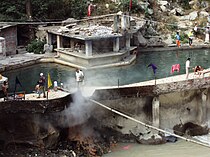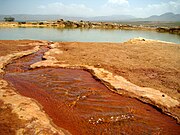
Back ينبوع معدني Arabic Mineralni izvor BS Minerální pramen Czech Mineralquelle German Mineralfonto Esperanto چشمه آبمعدنی Persian Source thermale French Հանքային աղբյուրներ Armenian Ölkelda (uppspretta) Icelandic 鉱泉 Japanese




Mineral springs are naturally occurring springs that produce hard water, water that contains dissolved minerals. Salts, sulfur compounds, and gases are among the substances that can be dissolved in the spring water during its passage underground. In this they are unlike sweet springs, which produce soft water with no noticeable dissolved gasses. The dissolved minerals may alter the water's taste. Mineral water obtained from mineral springs, and the precipitated salts such as Epsom salt have long been important commercial products.
Some mineral springs may contain significant amounts of harmful dissolved minerals, such as arsenic, and should not be drunk.[1][2] Sulfur springs smell of rotten eggs due to hydrogen sulfide (H2S), which is hazardous and sometimes deadly. It is a gas, and it usually enters the body when it is breathed in.[3] The quantities ingested in drinking water are much lower and are not considered likely to cause harm, but few studies on long-term, low-level exposure have been done, as of 2003[update].[4]
The water of mineral springs is sometimes claimed to have therapeutic value. Mineral spas are resorts that have developed around mineral springs, where (often wealthy) patrons would repair to "take the waters" — meaning that they would drink (see hydrotherapy and water cure) or bathe in (see balneotherapy) the mineral water. Historical mineral springs were often outfitted with elaborate stone-works — including artificial pools, retaining walls, colonnades, and roofs — sometimes in the form of fanciful "Greek temples", gazebos, or pagodas. Others were entirely enclosed within spring houses.
- ^ "Import Alert 29-02: Detention Without Physical Examination of Bottled Water due to Arsenic Due to Inorganic Arsenic". www.accessdata.fda.gov. FDA.
- ^ "Bottled water brand with high levels of arsenic pulled from store shelves". NBC News.
- ^ "PUBLIC HEALTH STATEMENT: Hydrogen Sulfide" (PDF). DEPARTMENT of HEALTH AND HUMAN SERVICES, Public Health ServiceAgency for Toxic Substances and Disease Registry, US Centers for Disease Control. December 2016.
- ^ "Hydrogen Sulfide in Drinking-water" (PDF). World Health Organization. 2003.